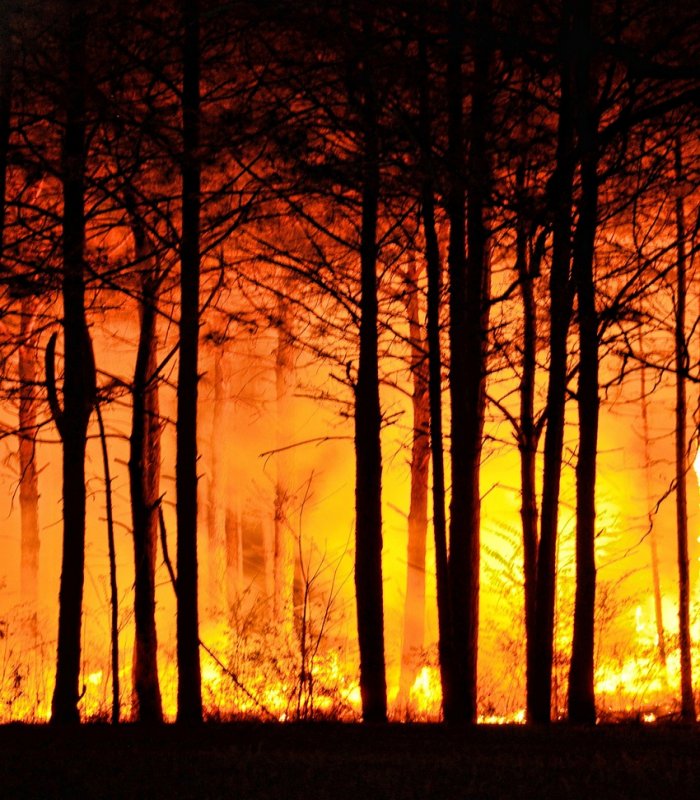Global Carbon Dioxide Emissions From Forest Fires Increase By 60 Percent
Eddie Gonzales Jr. – MessageToEagle.com – A new study shows CO2 emissions from forest fires have increased by 60% globally since 2001 and nearly tripled in some northern boreal forests.
Image credit: amissphotos – Pixabay
The study grouped world areas into ‘pyromes’ — regions where forest fire patterns are affected by similar environmental, human, and climatic controls — revealing the key factors driving recent increases in forest fire activity.
This is among the first global studies comparing forest and non-forest fires.
It reveals that in major pyromes across boreal forests of Eurasia and North America, fire emissions nearly tripled from 2001 to 2023. Emissions increased significantly in extratropical forests, adding half a billion tonnes of CO2 yearly, shifting the emission epicenter from tropical to extratropical regions.
Increased emissions are linked to fire-favorable weather, like hot-dry conditions during heatwaves and droughts, and accelerated forest growth creating more fuel. These trends are driven by rapid warming in the high northern latitudes, occurring twice as fast as the global average.
The study shows a worrying rise in both the extent and severity of forest wildfires over the last two decades. The carbon combustion rate, indicating fire severity by measuring carbon emissions per area burned, increased nearly 50% globally between 2001 and 2023.
An international team of scientists from the UK, the Netherlands, US, Brazil, and Spain warn that further expansion of forest fires can only be averted if the primary causes of climate change, such as fossil fuel emissions, are tackled.
“Increases in both the extent and severity of forest fires have led to a dramatic rise in the amount of carbon emitted by forest fires globally. Startling shifts in the global geography of fires are also underway, and they are primarily explained by the growing impacts of climate change in the world’s boreal forests.,” Lead author Dr Matthew Jones, of the Tyndall Centre for Climate Change Research at UEA, said.
“To protect critical forest ecosystems from the accelerating threat of wildfires, we must keep global warming at bay and this underscores why it is so vital to make rapid progress towards net zero emissions.”
Threats to carbon storage
Forests are vital for carbon storage, helping remove CO2 from the atmosphere and slowing global warming. They also aid in meeting climate targets, with reforestation and afforestation schemes offsetting emissions from sectors like aviation and certain industries.
The success of these schemes relies on permanent carbon storage in forests, but wildfires pose a threat. Extratropical fires emit half a billion tonnes more CO2 than 20 years ago, and long-term effects depend on forest recovery. More severe forest fires indicate emissions exceed the carbon captured by post-fire recovery.
“The steep trend towards greater extratropical forest fire emissions is a warning of the growing vulnerability of forests and it poses a significant challenge for global targets to tackle climate chang,” said Dr Jones, a NERC Independent Research Fellow.
“We know that forests rebound poorly after the most severe fires, so there is huge interest in how the observed increases in fire severity will influence carbon storage in forests over the coming decades. This demands our close attention.”
Escalating wildfire impacts masked until now
Increased emissions from forest fires contrast with reduced burning of tropical savannahs. Since 2001, the global area burned by all fires decreased by a quarter, mainly due to less savannah burning.
Forest fires burn more severely and release more harmful smoke than savannah fires, posing major threats to nearby residents and distant communities affected by poor air quality.
The authors say the study debunks the narrative that falling overall annual area burned by fire globally means falling wildfire impact.
“Until now, reduced burning in the already fire-prone savannahs and grasslands has masked increases in forest fire extent and severity that are hugely consequential for society and the environment,” said Dr Jones. “Our work shows that fires are increasingly happening where we don’t want them to — in forests, where they present the greatest threat to people and to vital carbon stores.”
Managing wildfires
Machine learning was crucial for discovering new insights into the changing global geography of forest fires. It grouped the world’s forest ecoregions into 12 pyromes, helping researchers isolate climate change effects from other factors like land use.
Dr Jones said: “Substantial financing is required to support strategic programs of forest management, stakeholder engagement, and public education, all of which represent a meaningful shift of fire management strategy from largely reactive to increasingly proactive.
“For example, priority areas for forest management and fire breaks must be defined based on proactive monitoring of forest productivity, particularly in the extratropics. Managing fuel loads in places where they could present greatest danger during fire-favourable weather is a key priority for limiting the severity and impact of fires when they do occur.”
Written by Eddie Gonzales Jr. – MessageToEagle.com Staff Writer











